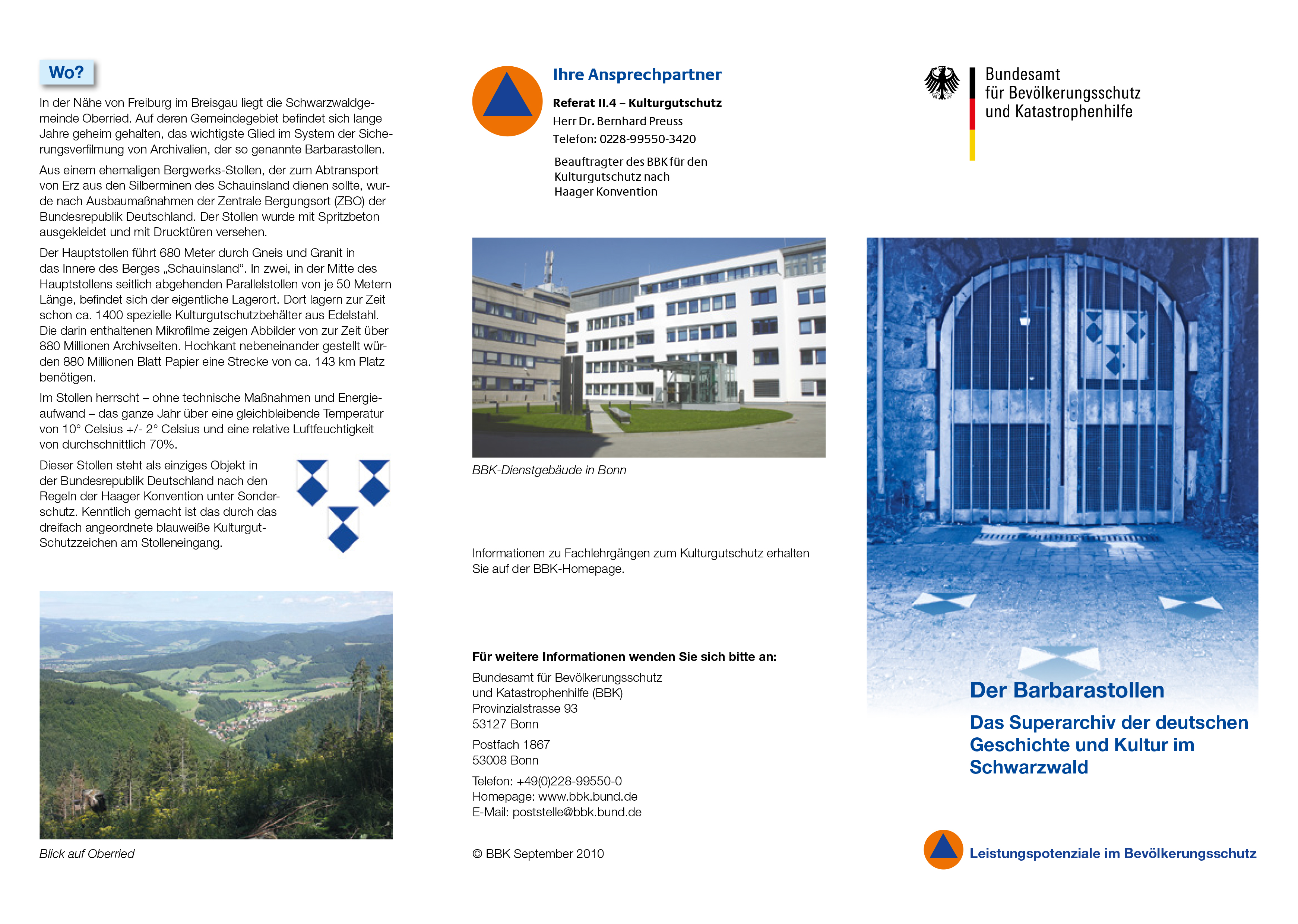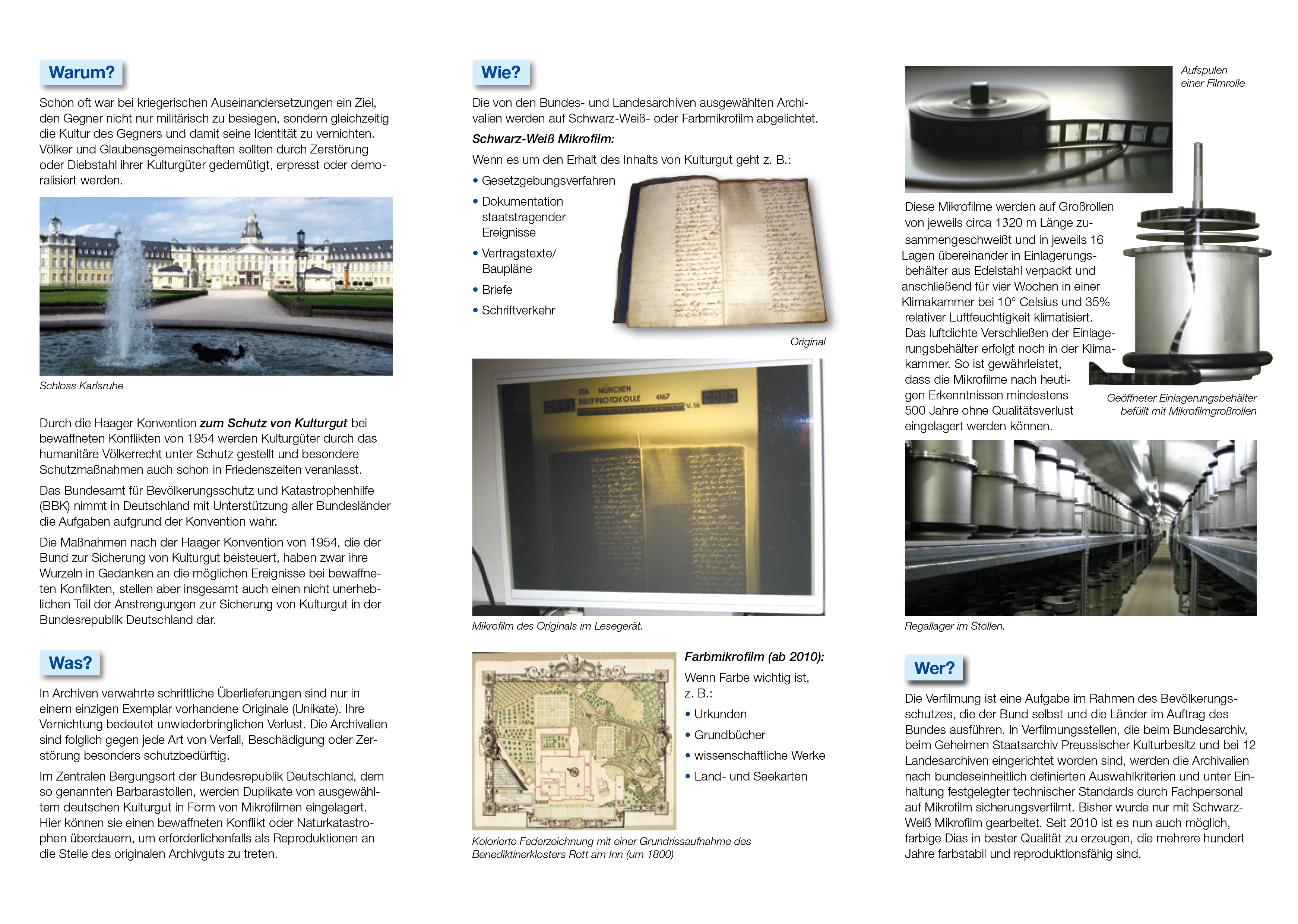Flyer from the Barbarastollen, Germany’s Underground Cultural Archive of Microfilmed Documents (2010)
Abstract
The Barbarastollen is an underground archive of microfilmed documents housed in an old silver mine near Freiburg im Breisgau. It houses over 32,000 kilometers of microfilm, drawn from German archives, museums, and libraries. The films are sealed in special stainless-steel containers that should last at least 500 years. The first deposits were made in 1974; four years later, in 1978, the archive was registered with UNESCO as the Central Storage Site of the Federal Republic of Germany [Zentrale Bergungsort der Bundesrepublik Deutschland]. After the Wende, microfilmed archival records from the former GDR were deposited in the Barbarastollen for the first time.
Source
The Federal Office for Civil Protection and Disaster Assistance
The Barbarastollen
The Super Archive of German History and Culture in the Black Forest
Why?
Often the goal in wartime is not just to defeat the enemy militarily but also to eradicate the enemy’s culture and, by extension, the enemy’s identity. The destruction or theft of cultural heritage is used to humiliate, blackmail, or demoralize peoples and religious communities.
The Hague Convention for the Protection of Cultural Property in the Event of Armed Conflict of 1954 places cultural assets under protection by international humanitarian law and provides for special protective measures, even in times of peace.
In Germany, the Federal Office for Civil Protection and Disaster Assistance (BBK), with the support of all the federal states [Länder], fulfills the tasks arising from the Convention.
Although the federal government measures to safeguard cultural heritage introduced in accordance with the Hague Convention of 1954 are rooted in concerns relating to wartime events, they also reflect in no small part overall government efforts to safeguard cultural heritage in the Federal Republic of Germany.
What?
Written records kept in archives are originals (unique documents) and are only available in a single copy. Their destruction would represent an irretrievable loss. Therefore, archival documents require special protection against any type of deterioration, damage, or destruction.
Duplicates of select German cultural assets are stored as microfilms in the Central Storage Site of the Federal Republic of Germany, the so-called Barbarastollen. Here, they can survive armed conflict or natural disasters and, if necessary, can take the place of the original.
How?
Select archival records chosen by the Federal Archives and the State Archives [Landesarchive] are copied onto black and white or colored microfilm.
Black and White Microfilm:
When the preservation of cultural assets is important. For example
• Legislative procedures
• Documentation of state events
• Contracts/construction plans
• Letters
• Correspondence
Colored Microfilm (starting in 2010):
Whenever color is important, for example
• Certificates
• Land registry
• Scientific works
• Maps and sea charts
These microfilms are spliced together on large rolls, each about 1320 meters long, and stacked in 16 layers, one on top of the other, in stainless-steel storage containers and then conditioned for four weeks in a climate-controlled chamber at a constant 10º C (50º F) temperature and 35% relative humidity. The air-tight sealing of the containers takes place in the climate-controlled chamber. According to current knowledge, this guarantees that the microfilms can be stored for at least 500 years without loss of quality.
Who?
The microfilming process is a matter of civil protection and is carried out by the federal government and the federal states [Länder] on behalf of the federal government.
Filming sites have been set up at the Federal Archives, the Secret State Archives of the Prussian Cultural Heritage Foundation [Geheimes Staatsarchiv Preußischer Kulturbesitz], and at 12 State Archives. Trained professionals microfilm archival materials in accordance with established technical standards and selection criteria that applies nationwide.
Only black and white film has been used until now. In 2010, it became possible to produce the highest quality colored slides, which are color-fast and viable for hundreds of years.
Where?
In the vicinity of Freiburg im Breisgau lies the Black Forest town of Oberried. It houses the most crucial part of the German effort to systematically safeguard archival materials on microfilm, the so-called Barbarastollen, which was kept secret for many years.
After an expansion, a former mining tunnel [Stollen] originally used to transport ore from the silver mines of the Schauinsland became the Central Storage Site [Zentrale Bergungsort or ZBO] for the cultural heritage of the Federal Republic of Germany. The tunnel was coated with sprayed concrete and outfitted with pressure-tight doors. The main tunnel extents 680 meters (0.4 miles) through gneiss and granite into the interior of the Schauinsland mountain. The actual storage site is located in two parallel tunnels, each 50 meters long, that branch off laterally in the middle of the main tunnel. Currently, the site holds 1,400 specially made stainless-steel containers designed for the protection of cultural assets. They contain over 880 million pages of archival material on microfilm. If placed upright and next to each other, 880 million sheets of paper would extend for 143 km (almost 89 miles). Without any technical effort or additional energy expenditure, the temperature inside the tunnel remains constant throughout the year at around 10º C (+/- 2º C), or 50º F (+/- 4ºF), and 70% relative humidity. This tunnel is the only site in the Federal Republic of Germany that is under special protection under the Hague Convention. It is clearly marked as such with a triple blue and white Cultural Heritage Protection sign at the entrance.
[…]


Source: Bundesamt für Bevölkerungsschutz und Katastrophenhilfe [Federal Office of Civil Protection and Disaster Assistance (BBK)], Der Barbarastollen. Das Superarchiv der deutschen Geschichte und Kultur im Schwarzwald. Flyer, September 2010.